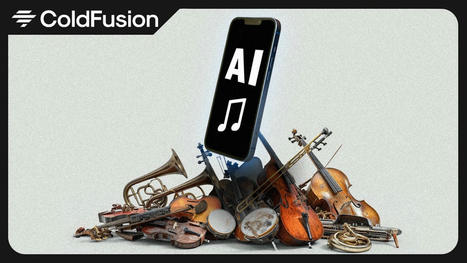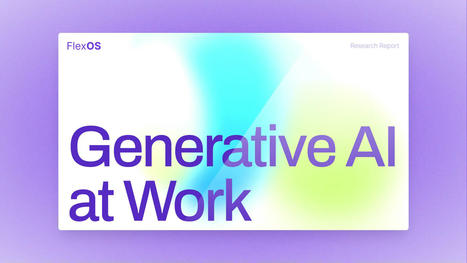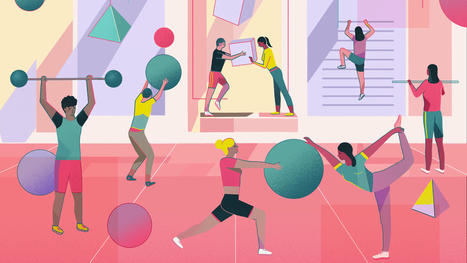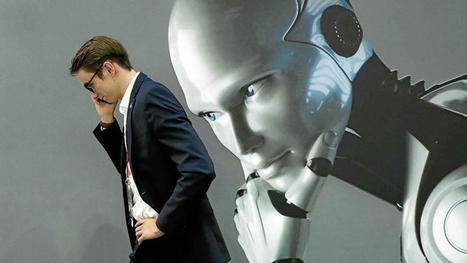 Your new post is loading...

|
Scooped by
Edumorfosis
|
Los datos de nuestra encuesta muestran el creciente optimismo y la confianza en la IA. Al profundizar en las tendencias de inversión, observamos que las empresas están recalibrando sus carteras de inversión y priorizando el edge computing y las nubes públicas y privadas. Cabe destacar que las empresas están volviendo a enfocar sus presupuestos en la modernización de aplicaciones y la migración a la nube, al tiempo que reducen las inversiones en infraestructura de servidores y hardware.
En 2024, las expectativas y la realidad convergen para la IA. Aunque la IA ha acelerado considerablemente la innovación y ha mejorado los procesos de toma de decisiones, no siempre los aumentos de productividad y de ventas previstos se materializaron. Nuestra investigación explora la tracción de los casos de uso de la IA, los desafíos para medir el retorno de la inversión (ROI) y el incipiente pero crítico dominio de la gobernanza de la IA.
En el uso de la nube, un cambio hacia la infraestructura de nube privada es claro, mientras que las organizaciones lidian con las complejidades de la migración a la nube, los recursos limitados y las preocupaciones relacionadas con la seguridad. Un análisis comparativo del ROI de las nubes privadas frente a las públicas revela una creciente inclinación hacia las soluciones de nube híbrida. Combinan la escalabilidad y la rentabilidad de las nubes públicas con la seguridad y el control optimizados de las nubes privadas, al ofrecer un enfoque flexible y mejorado para satisfacer diversas necesidades comerciales.
La escasez de talento presenta su propio conjunto de desafíos, en particular en los sectores de IA y tecnología. Las organizaciones se enfrentan a las dificultades de contratar profesionales con experiencia en un mercado en el que la demanda supera a
la experiencia. Este informe explora estrategias para abordar estas deficiencias, y hace hincapié en la importancia de la mejora de habilidades y las opciones tecnológicas inteligentes para ampliar la reserva de talento.

|
Scooped by
Edumorfosis
|
La automatización de tareas rutinarias y su efecto en los empleos tradicionales.
La automatización de tareas rutinarias ha sido uno de los desarrollos más destacados en el ámbito laboral impulsado por la inteligencia artificial y la tecnología. Podríamos detallarlos cómo esta automatización está empezando a afectar a los empleos tradicionales:

|
Scooped by
Edumorfosis
|
The emergence of publicly accessible artificial intelligence (AI) large language models such as ChatGPT has given rise to global conversations on the implications of AI capabilities. Emergent research on AI has challenged the assumption that creative potential is a uniquely human trait thus, there seems to be a disconnect between human perception versus what AI is objectively capable of creating. Here, we aimed to assess the creative potential of humans in comparison to AI. In the present study, human participants (N = 151) and GPT-4 provided responses for the Alternative Uses Task, Consequences Task, and Divergent Associations Task. We found that AI was robustly more creative along each divergent thinking measurement in comparison to the human counterparts. Specifically, when controlling for fluency of responses, AI was more original and elaborate. The present findings suggest that the current state of AI language models demonstrate higher creative potential than human respondents.

|
Scooped by
Edumorfosis
|
La inteligencia es nuestro recurso principal y la fuente de toda actividad humana. No hay mayor prioridad que la inteligencia porque solo podemos conseguir nuestros objetivos si contamos con ella en suficiente cantidad. De hecho, TODO lo que haces, eres y tienes se lo debes a la inteligencia, la tuya, pero también de la de muchos otros. Los más inteligentes siempre tienen ventajas. Por eso, todos queremos más inteligencia. No tengo duda de que la inteligencia ya es el commodity más demandado porque sostiene la ventaja competitiva de cualquier organización o persona. Y la IA nos va a permitir que la inteligencia sea más barata y por tanto se masifique. Todo objeto se volverá inteligente porque incluirá software, no solo para hacer cosas sino para aprender de lo que hace y ofrecerte recomendaciones.

|
Scooped by
Edumorfosis
|
There’s always something sitting between people and the world around them. Whether it’s a tool, a story, a brand, or a person, external factors influence what they think, how they interact, and the way they feel as they move through life.
These trends explore the evolution of these factors—because it’s putting society into a state of flux. People are now deconstructing everything as they try to figure out who they are in the world.
New intelligence layers are emerging in digital interactions, while people are examining the consequences of past experiences. The harmony between people, technology and business is showing tensions.
Accenture Life Trends identify and explore the various factors we expect will change the way people experience and interact with brands, organizations, governments and systems in the coming year and beyond.

|
Scooped by
Edumorfosis
|
The data is in: 2024 is the year AI at work gets real. Use of Generative AI has nearly doubled in the last six months,1 with 75% of global knowledge workers using it. And employees, struggling under the pace and volume of work, are bringing their own AI to work. While leaders agree AI is a business imperative, many believe their organization lacks a plan and vision to go from individual impact to applying AI to drive the bottom line. The pressure to show immediate ROI is making leaders inert, even in the face of AI inevitability.
We’ve come to the hard part of any tech disruption: moving past experimentation to business transformation. Just as we saw with the advent of the internet or the PC, business transformation comes with broad adoption. Organizations that apply AI to drive growth, manage costs, and deliver greater value to customers will pull ahead.
At the same time, the labor market is set to shift again—with AI playing a major role. Despite fears of job loss, leaders report a talent shortage for key roles. And as more employees eye a career move, managers say AI aptitude could rival experience. For many employees, AI will raise the bar but break the career ceiling.
To help leaders and organizations overcome AI inertia, Microsoft and LinkedIn looked at how AI will reshape work and the labor market broadly, surveying 31,000 people across 31 countries, identifying labor and hiring trends from LinkedIn, and analyzing trillions of Microsoft 365 productivity signals as well as research with Fortune 500 customers. The data points to insights every leader and professional needs to know—and actions they can take—when it comes to AI’s implications for work.

|
Scooped by
Edumorfosis
|
AI systems are already capable of deceiving humans. Deception is the systematic inducement of false beliefs in others to accomplish some outcome other than the truth. Large language models and other AI systems have already learned, from their training, the ability to deceive via techniques such as manipulation, sycophancy, and cheating the safety test. AI’s increasing capabilities at deception pose serious risks, ranging from short-term risks, such as fraud and election tampering, to long-term risks, such as losing control of AI systems. Proactive solutions are needed, such as regulatory frameworks to assess AI deception risks, laws requiring transparency about AI interactions, and further research into detecting and preventing AI deception. Proactively addressing the problem of AI deception is crucial to ensure that AI acts as a beneficial technology that augments rather than destabilizes human knowledge, discourse, and institutions.

|
Scooped by
Edumorfosis
|
There is a war going on. Humanity and nature are on one side and Big Tech is on the other. The two sides are not opposed. They are orthogonal. The human side is horizontal and the Big Tech side is vertical.*
The human side is personal, social, self-governed, heterarchical, open, and grounded in the physical world. Its model is nature, and the cooperative contexts in which competition, creation, and destruction happen in the natural world.
The Big Tech side is corporate, industrial, hierarchical, competitive, mechanistic, extractive, and closed, even though it produces many positive-sum products and services that are good for people and good for nature. It is also, being competitive and rewarding toward winner-take-most outcomes, dominated by giants.

|
Scooped by
Edumorfosis
|
Despite the immense potential of increasingly sophisticated Artificial Intelligence (AI) to boost performance, efficiency, growth, and customer experiences, not all organizations are ready to enjoy AI’s benefits.
In sectors such as healthcare, pharma, biotech, manufacturing, and finance, some organizations struggle to build the powerful, unified infrastructure they need to manage AI’s steep processing, data, and security demands of applying reliable large language models (LLMs). Most also lack the necessary expertise to build AI-driven strategy and keep pace with compliance changes.

|
Scooped by
Edumorfosis
|
Generative AI doesn’t exist in a vacuum. The rapid advancements we’ve seen in generative AI over the past year or so have been made possible by other tech breakthroughs. Cloud computing, for example, democratizes access to AI technologies. 5G amplifies the potential of generative AI by facilitating real-time analytics and AI processing. And the Internet of Things provides a rich source of data for generative AI models to mine.

|
Scooped by
Edumorfosis
|
Artificial Intelligence (AI) is rapidly transforming the workplace, with profound implications for how executives and workers navigate their career paths. As it continues to revolutionize industries, business leaders stress the urgency of acquiring AI-related skills. A staggering 87% of managers struggle to find staff with AI capabilities, while 79% of C-suite executives fear being unprepared for the future without AI knowledge.

|
Scooped by
Edumorfosis
|
Throughout history, creating a complete piece of music has always been a human process. There have been attempts to compose and render songs using computers before, but frankly they weren't great.
Today, that all changes with two AI music platforms. Udio and Suno. In this episode, we'll take a look at both and talk to experts like Rick Beato to see what this means for the future of the music industry.

|
Scooped by
Edumorfosis
|
The OpenAI and Sam Altman saga was one of the most debated in years. And for good reason: AI and the future of the companies bringing us these tools impact us all.
Knowing the massive impact AI will have on the future of work, we set out to understand how much knowledge workers are familiar with Generative AI tools, how often they use them, and which tools are most popular.
Leaders who want their teams to focus on what matters have shifted to AI early on to offload manual, repetitive tasks that can be easily automated. How about the rest?
|

|
Scooped by
Edumorfosis
|
As organizations increasingly integrate spatial computing into their technology roadmaps, helping workplace learners successfully navigate the evolution from primarily physical to virtual or hybrid working environments is becoming a strategic imperative for many organizations. Understanding how early adopters are using spatial computing can assist workplace learning practitioners as they consider the integration of these technologies into their future-of-work strategies and plans.
This article describes the evolving spatial computing adoption landscape across multiple industries, sectors and business functions and provides key insights into the benefits of spatial computing capabilities to organizations. It also offers practical strategies for leaders who are considering exploring these technologies as well as those who have already begun experimentation.

|
Scooped by
Edumorfosis
|
La adaptación de las empresas y las organizaciones a la Era de la Inteligencia Artificial, de forma humilde, algo que nos podríamos empezar a preguntar es ¿Para que necesitamos la IA? ¿Cuál es nuestro objetivo real que queremos conseguir? ¿Qué es necesario para que podamos mejorar ya sea en un presente y en un futuro? Si tenemos estos conceptos básicos, puede que nos funciones la adaptación y aplicación de la IA. Aunque existe, el error, fallo como muchas veces hemos hablado, ya que al final también somos personas humanas, es decir que seguramente “tropezaremos con la misma piedra de tiempos anteriores”.

|
Scooped by
Edumorfosis
|
In practice, Generative AI tools use different strategies for different types of data when building large data models—the complex neural networks that organize vast amounts of information. For example, those that draw on textual sources segregate individual tokens, usually words. Each token is assigned an “embedding” or “vector”: a numerical matrix representing how and where the token is used compared to others. Collectively, the vector creates a mathematical representation of the token’s meaning. An image model, on the other hand, might use pixels as its tokens for embedding, and an audio one sound frequencies. A multimodal AI model typically relies on several unimodal ones. As Henry Ajder, founder of AI consultancy Latent Space, puts it, this involves “almost stringing together” the various contributing models. Doing so involves various techniques to align the elements of each unimodal model, in a process called fusion. For example, the word “tree”, an image of an oak tree, and audio in the form of rustling leaves might be fused in this way. This allows the model to create a multifaceted description of reality.

|
Scooped by
Edumorfosis
|
The evolution of the digital technology ecosystem is driving economic and societal changes, with the Information and Communication Technology (ICT) sector at its core proving dynamic and resilient in the face of economic headwinds. As digital technologies like artificial intelligence, virtual reality and next generation networks permeate our lives and the economy, it is critical to unleash innovation responsibly, ensure that the benefits of these technologies are widely shared, and reduce the risks technological advances can pose to well-being and society.

|
Scooped by
Edumorfosis
|
By now, almost everyone has experimented with generative AI. And as leaders commit to rolling out Microsoft Copilot across their workforces, the individual productivity gains and organization-wide effects will be unmistakable. If 2023 was all about the promise of AI, 2024 will be about the proof.
To build an AI-powered organization, where new technology supports human ingenuity at every level, leaders need to help their teams embrace new mindsets and habits. As 2024 opens, here are five habits to hone as you guide your teams through the transition.

|
Scooped by
Edumorfosis
|
The data is in: 2024 is the year AI at work gets real. Use of generative AI at work has nearly doubled in the past six months. LinkedIn is seeing a significant increase in professionals adding AI skills to their profiles, and most leaders say they wouldn’t hire someone without AI skills. But with many leaders worried their company lacks an AI vision, and employees bringing their own AI tools to work, leaders have reached the hard part of any tech disruption: moving from experimentation to tangible business impact.

|
Scooped by
Edumorfosis
|
The workplace is changing due to artificial intelligence (AI) and cognitive robots, which present both new opportunities and difficulties for employees, businesses, and society as a whole. Artificial intellect (AI) is the capacity of robots to carry out activities like learning, thinking, and decision-making that typically need human intellect. Robots that use artificial intelligence (AI) and other technologies to detect, comprehend, and interact with their surroundings are known as cognitive robots.

|
Scooped by
Edumorfosis
|
Nya Étienne, who is a journalist and TikTok content creator, refers to this concept as the rise of "the Intellectual Influencer."
"People are facing burnout on social media," she told Business Insider. "They want to see content with more substance, and they want to see influencers and creators as three-dimensional people, not just as people trying to sell them things".

|
Scooped by
Edumorfosis
|
The world of work is in full metamorphosis, forever changed by the seismic shifts of the past few years and accelerated by the imminent human-machine teaming revolution. Just as organizations were settling into a new normal – with a focus on hybrid working, comprehensive health and well-being, digitalization, and upskilling – Generative AI (Gen AI) burst onto the scene. Changing not only how people work but the work experience itself, Gen AI has been met with equal measures of unease and excitement. Will it produce a real productivity lift? Can the increased risk exposure be effectively managed, and is it worth it? What will be the permanent impact on the competitive landscape? These are the conversations dominating boardrooms and team chats, with one universal truth emerging: Unlocking the potential of this new world of work means keeping people at the heart of the transformation agenda. There is no escaping the need for new ways of working and new ways to value workers. The societal dynamics emanating from the last few years (including louder calls for fair pay, better working conditions, and less environmental impact) are aggressively reshaping the work contract. Leading companies are rethinking their People practices and leveraging greater talent science to ensure a more sustainable, equitable and intuitive work experience. The urgency is coming from all stakeholders. Two in five workers believe that the world of work is fundamentally broken and one in four wish they didn’t have to work at all. People crave the peace of mind that comes with job security and financial well-being – staples that become increasingly important during times of upheaval. Executives are also seeking solid ground, focused on keeping their business running by addressing inflation, digital acceleration, and alternative work models. Climate concerns are hitting closer to home as more frequent extreme weather events impact business continuity. Cyber risk has been bumped from its top spot in 2022, and significantly fewer executives are accounting for an overall heightened risk environment in their plans. HR remains anxious about rising labor costs, managing a remote workforce, and skills shortages. And 89% of asset managers see an engaged workforce as a key driver of company value.

|
Scooped by
Edumorfosis
|
Traditional marketing approaches sometimes fall short when it comes to captivating consumers and making a lasting impression on brands.
However, virtual reality (VR) technology has just emerged, providing companies with a potent weapon that may transform their advertising strategies. Startups may make a lasting impact on their target audience by using VR's immersive and interactive nature to create fascinating experiences.

|
Scooped by
Edumorfosis
|
La inteligencia artificial está transformando profundamente la manera en que interactuamos con la tecnología. Se abre un paradigma nuevo en la forma de trabajar, crear y desarrollar cualquier tipo de contenido y, por lo tanto, surge la necesidad de desarrollar nuevas habilidades para trabajar con ella.
Al mismo tiempo, resulta conveniente revisar el conjunto de conocimientos y destrezas que los humanos hemos empleado hasta ahora para trabajar e identificar cuáles de ellas persisten, cuáles caducan y cuáles debemos potenciar.

|
Scooped by
Edumorfosis
|
Los profesionales de cuello blanco, aquellos que tienen un nivel educativo y unos salarios más altos, serán quienes se verán más afectados por la generalización de la Inteligencia Artificial generativa IAG, al contrario de lo que sucedió en anteriores revoluciones cuyas consecuencias impactaron de manera más notoria en los trabajadores sobre todo manuales, según recoge un informe de la Agencia Vasca de Innovación Innobasque.
|




 Your new post is loading...
Your new post is loading...
![[PDF] Informe de perspectivas de TI para 2024 | Edumorfosis.Work | Scoop.it](https://img.scoop.it/c0I4i7F5Ub1op0ya2tkqqzl72eJkfbmt4t8yenImKBVvK0kTmF0xjctABnaLJIm9)




![[PDF] Accenture Life Trends 2024 | Edumorfosis.Work | Scoop.it](https://img.scoop.it/k5k-8wl44kNwTorWpzIC1Dl72eJkfbmt4t8yenImKBVvK0kTmF0xjctABnaLJIm9)
![[PDF] AI at work is here. Now comes the hard part | Edumorfosis.Work | Scoop.it](https://img.scoop.it/iGEwGNcqbreJn-hWtBe4Sjl72eJkfbmt4t8yenImKBVvK0kTmF0xjctABnaLJIm9)









![[PDF] Multimodal: AI’s new frontier | Edumorfosis.Work | Scoop.it](https://img.scoop.it/zLiBXroU2qBjuSbNC0lFlDl72eJkfbmt4t8yenImKBVvK0kTmF0xjctABnaLJIm9)

![[PDF] OECD Digital Economy Outlook 2024 | Edumorfosis.Work | Scoop.it](https://img.scoop.it/oIde7Z-NSOOV-rCfJ45cSjl72eJkfbmt4t8yenImKBVvK0kTmF0xjctABnaLJIm9)




![[PDF] Global Talent Trends Report 2024 | Edumorfosis.Work | Scoop.it](https://img.scoop.it/Qw21Eytry5efPB48U9iZIDl72eJkfbmt4t8yenImKBVvK0kTmF0xjctABnaLJIm9)







